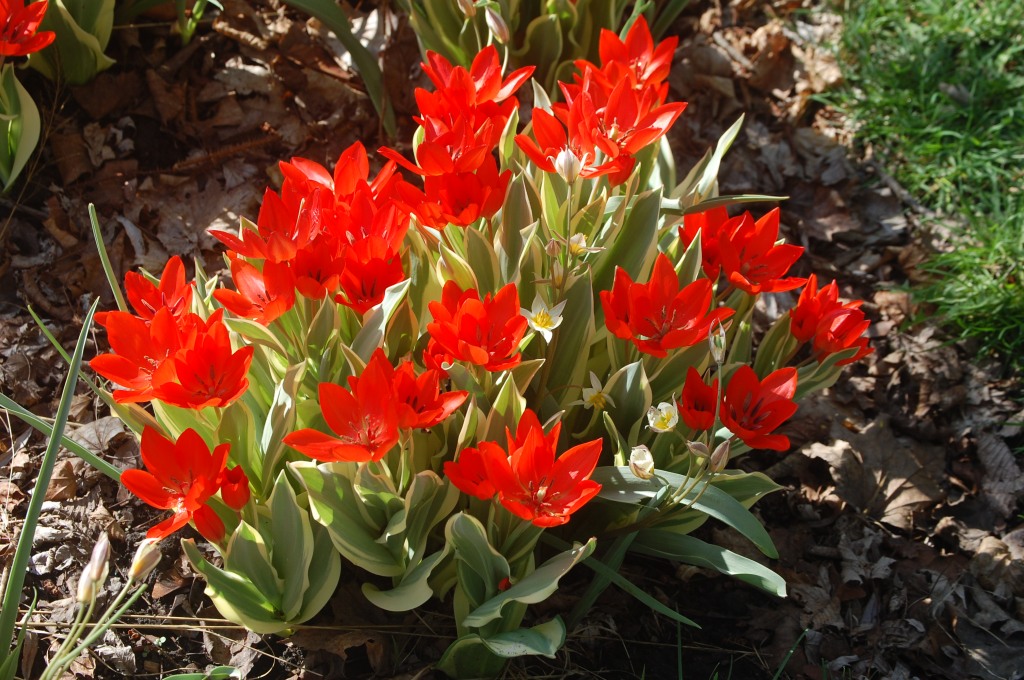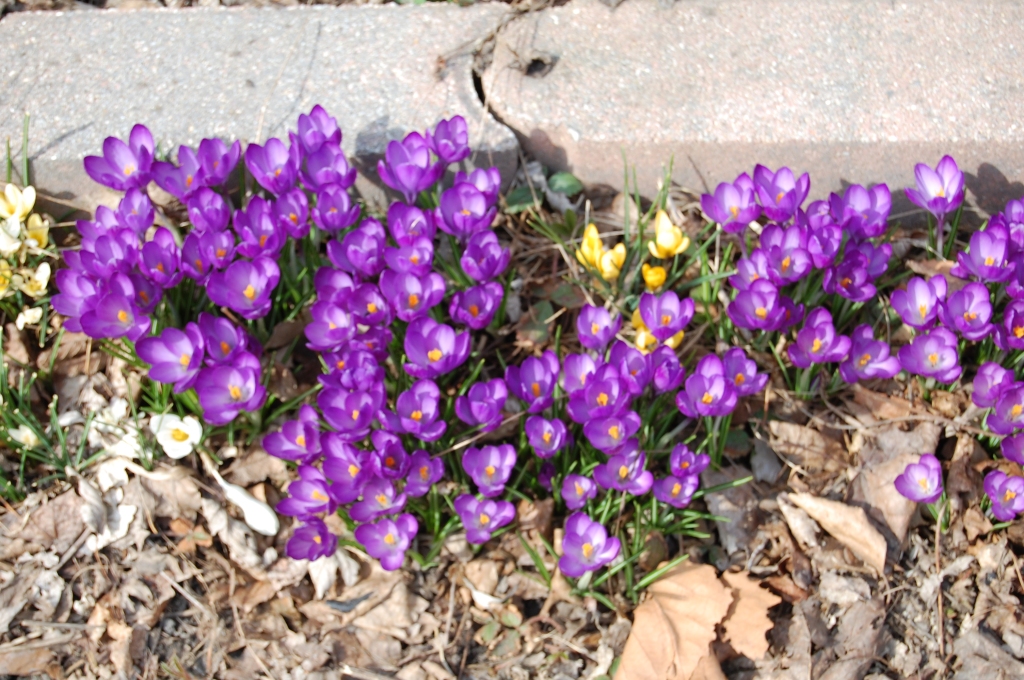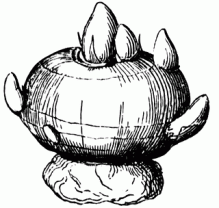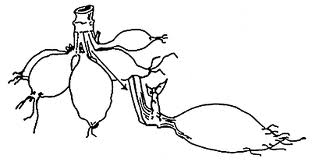Getting to the Tuberous Root of the Matter
Botanists like to make things complicated. Because of this, an almond is not really a nut but a drupe, and watermelons are actually berries. (Look it up if you don’t believe me.) Similarly, not all things we think of as bulbs are really bulbs. They may be corms, rhizomes, tubers, or tuberous roots.

This wouldn’t matter except for the risk of botanical humiliation. Say you are at a dinner party and you boast about the hundreds of crocus bulbs you planted. “They’re actually corms, not bulbs,” someone says, a patronizing smile playing upon their lips.
At this point you have several choices. You can pretend you meant to say corms all along. You can try to create a diversion by knocking over someone’s glass of wine. Or you can demand satisfaction for this insult: weed whackers at dawn.

Better you should minimize the risk of violence and emotional trauma by getting clear on your bulbous structures.
This topic is on my mind because I just started a class at the Chicago Botanic Garden on hardy bulbs (and corms, etc.). The other night this subject was explained and I feel inspired to share my enlightenment with you. You’re welcome.
But before we get started I also want to share an amazing bulb fact. Did you know that if you plant bulbs at a less than ideal depth, the bulbs themselves will move to the spot they like best? They do this with contractile roots, which pull the bulbs through the soil. Don’t know about you, but that makes me feel so much better.
And now for the bulbous structures.

True bulbs. True bulbs are like miniature plants – if you cut them open, you’ll see a bud, stem, and foliage at the center. The bud is surrounded by scales that hold stored energy, and sometimes a papery tunic. The scales are held together by a basal plate. Tulips, daffodils, hyacinths, scillas, snowdrops, lilies, and alliums are all true bulbs.

Corms. Corms are hunks of stem tissue connected to a basal plate. The tissue is just tissue – a cross section will show no rings or parts. Roots grow from the basal plate. Corms live for only one year, but they replace themselves energetically. Crocus, crocosmia, gladiolus, colchicums, and erythroniums are corms.

Tubers. Like corms, tubers are hunks of stem tissue. Unlike corms, tubers are perennial. The stem portions sprout eyes and roots. Potatoes are tubers, of course, as are anemones and corydalis.

Tuberous roots. Like tubers except the mass is made of root tissue instead of stem tissue. How do we know? Stem cells have little bundles of vascular tissues around the periphery, root cells have vascular tissues in a central core. Got that? Me neither, but just say it with confidence while looking people straight in the eye. Dahlias, sweet potatoes, and eremerus have tuberous roots.

Rhizomes. Rhizomes are horizontal stems growing on or just below the surface. Important note: “horizontal” means you don’t plant rhizomes pointing down, which is something I did for years. Rhizomes include bearded iris, trillium, Solomon’s seal, hardy geranium, and canna lily.
So. Now you can amaze your friends at parties with your knowledge of bulbs and bulb-like plants. They may be edging away from you, but they will be amazed.





Great info – and I love the way you presented it! I wish you had written the manual for the first botany course I took…a little humour would have been refreshing and perhaps made it a little easier to remember everything… 🙂 I’m massively behind on reading everyone’s blogs – are your crocuses blooming now? I know you have snowdrops already – lovely! We’re once again buried under snow and more is on its way tonight.
No crocus yet. That picture is from last year.
Neat.
I have been thinking about something that maybe you can help me with …
about a month ago I sliced off the bottom of a bok choy and put it in some water. Almost immediately (2 days) it sprouted almost perfectly formed mini bok choys at the inner junctures. It was all very fractal. Is bok choy some kind of crazy bulb? How is it able to clone itself like that?
I don’t think cabbage are bulbs. I think what you were doing was basically propagating your book Choy through making a cutting, like you would with coleus.
Yeah. Now I feel so dumb for asking. It is probably a kind of vegetative stem-cell kind of reproduction.
Asking questions is never dumb!
Your kindness eases my blush. haha
Thank you.
I love your writing style Jason; I need to translate this trying, to keep the humour, for the group of wanna be gardeners I’m helping to teach. when we spoke about ‘bulbs’ they had only two names for all the different types. Cipolli (onions) and patate (you can guess that one). Notice everything is reduced to food here in Italy!
I must have Italian ancestry that’s been hidden from me.
Some of that I knew, but seeing your brilliant diagrams and explanations makes it all a lot clearer. Thanks a bunch! And now I am sending out the invitations for the spring party! 😉
Have fun!
And the wonderful thing about bulbs is that you can cut them up into tiny sections as long as each tiny bit has some of the basal plate and make new ones. Twin scaling is a wonderful way of getting new bulbs.
I have never done that. Should give it a try.
Love this post Jason, how wonderful too to be taking a class at the Chicago Botanic Gardens, that must be very fulfilling. For some reason really good horticultural educators are very limited over here. You are very fortunate indeed.
I am very lucky to live so close to CBG.
Sounds like they do excellent classes in Chicago! What a rude imaginary guest you met at your imaginary dinner party.
Excellent information beautifully illustrated, although if I were to start talking corms at dinner parties, I suspect I would be spending a lot of evenings with nothing but a cheese sandwich and a bulb catalogue for company.
Come to think of it, I haven’t been getting out much.
If you get to the part about sepals and petals, I could use a review on those too.
You have my promise on that.
They apparently never heard the old adage “KISS.” 🙂 Your class sounds like a fun learning experience.
The instructors are fun and know their stuff.
Agree with all of the above comments, like the humor and the way you depicted each type, and to attend classes at Chicago Botanical Gardens (wow, would love that too), Are you okay with reblogs of your topic – I’d like to share this one with my audience on my blog but always ask permission first. Cathy T
Go ahead! I’d be delighted.
That class seems very interesting. It looks like you are going to learn a lot.
I hope to.
I always like to just say “bulb”. It keeps me from seeming a TOTAL plant geek, like WAY across that line of normal.
On that note, I’ll just add, “thank you”, back…
Oh, embrace your inner geek!
Good informative post. It’s the rhizomes that always trip me up. There are so many on your list that I always figured were just ordinary perennials, and not growing from rhizomes. I love your humor, I could actually picture that dinner party, but I may have seen too many episodes of Downton Abbey.
I think that Mary would be the one making the snide comments about bulbs and corms.
Tuber or not tuber, that is the question! Great reminder! I didn’t know that there was a difference between tubers and tuberous roots and will have to memorize your definition for future dinner party use. (Who do you dine with?) Breaking into song can also distract from one’s lack of botanical acumen – Corm to be wild mmmm.
Or Tuber With Love?
Your class sounds fascinating. What do we cover next week? Hope you’ll share some more class notes.
I think next week we get into early spring bulbs, weather permitting.
Most informative….esoecially the rhizomes!!!xxx
I can never get enough of rhizomes, myself.
Nothing wrong with a little botany refresher every now and then. These are things all gardeners should know before they go planting those gladiolus corms upside down.
Some of us, including myself, need more refreshing than others.
Ha! I was giggling out loud, so I had to read your intro to my husband so he would understand my mirth. He laughed, too. That would be me–spilling that wine at the social gathering. Not only because I’d say something stupid, but also because I’m a klutz. 😉 Thanks for the lesson–I’ll try to get my bulbs, corms, tubers, and tuberous roots correct in the future. Let’s hope some of these various plants make an appearance soon and that the weather makes a definite turn toward spring!
I’m always spilling things whether I’m trying to create a diversion or not.
Is that true about the contractile roots? Because I have planted bulbs and they’re not coming up exactly where I put them. My friends and I have been baffled by this! New to your blog via an article in The Guardian, looking forward to reading more.
My instructors seem to know their business so I believe it is true. However, your bulbs could also be moved by squirrels or chipmunks who are hiding them for future snacking.
What a great course! Thanks for sharing what you learned…it is always good to review these things. Love how you wrote this post!
Thanks!
I do the same thing and generalize by saying bulbs often, yet knowing the difference. It flows better in conversation and most people would have no clue anyway. In MG meetings I say the right thing, and I know should all the time for consistency. Good post, Jason.
It does flow better in conversation to just say bulbs. Those other terms can get you quizzical looks.
I’ll vouch for the existence of contractile roots! They’re not uncommon on small crocus, lilies and gladiolus bulbs that are trying to find their place in the world…. oops two of those are corms, I hope I don’t get corrected.
Nice post, a great overview that doesn’t get too dry!
For bulbs that spread by seed, contractile roots must be necessary to bring young plants down to the right depth.
I did not know that crocus “bulbs” are actually corms. You really do learn something new every day!
Although some people try not to.
Now that is pretty darn fantastic! I have learned something new tonight and I just love that they adjust themselves! The magic of nature astounds me!! A wonderful weekend to you!!!
Same to you Nicole! I agree that it is awesome that the bulbs move themselves to the right depth. Guess they don’t really need us.
I actually had a bit of this info floating about in my head, but I love your explanation…easy to understand and remember. And I feel much better knowing the bulb will repair any damage I do when planting at the incorrect depth. Plants are so smart!
What a great post – thoroughly enjoyed!
Snowdrops just showing their heads out here in Lee County.